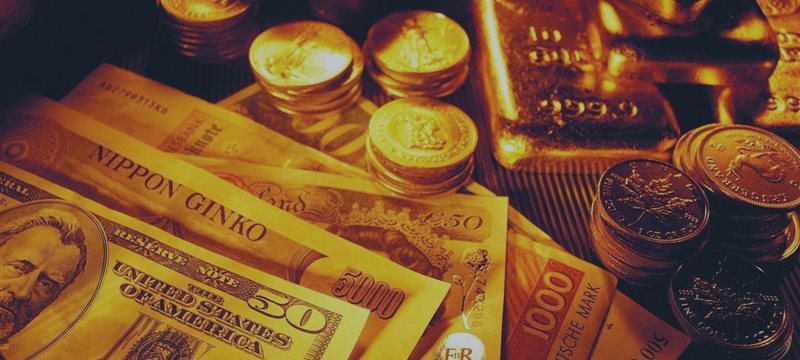
Gold Price 2015: Forecasts And Predictions by Commerzbank, Erica Rannestad, JP Morgan, Gary Christenson and more
The key theme on the gold price chart are the two trading ranges since gold’s all time highs. One trading range started end of 2011 and lasted till early 2013, the second one is still in play. In technical terms, both trading ranges took the form of a descending triangle.

Earlier this year, gold analyst Ronald-Peter Stoeferle released its gold price model for 2015 and beyond. Based on weighted probabilities, his model shows a long-term gold price of USD 1,515 per ounce. The distribution of gold price expectations remains positively skewed as evidenced by the following chart. Therefore, should there be a deviation from the currently widely expected path towards stabilization of the central banks’ balance sheet, significant upside potential for the gold price would result.

According to George Gero of RBC Capital Markets, gold is set to reverse its trend in 2015. During a CNBC interview for “Futures Now” he observed: “The decline from the $1,900s down to the $1,150s is a major decline, and it was reflected by all the funds fleeing gold and running into better-performing assets, whether it’s equities or debt, and that’s been continuing. In 2014, gold hasn’t been helped by the dollar’s rally. The greenback has shown serious strength against other currencies, which has reduced gold’s attractiveness. After all, since gold is priced in dollars, an increase in the value of a dollar means a decrease in the value of an ounce of gold. Additionally, since people buy gold to hedge against potential inflation, ebbing inflation fears dull gold’s appeal.”
Gero acknowledges that the sell off in crude is anti-inflationary—so
the people that have been looking for inflation haven’t really found it.
But he adds that “now you’re going to see some changes based on all the
stimulus in Europe, in China and in Japan.
Jeffrey Nichols, Senior Economic Advisor to Rosland Capital, says that 2015 promises to be a good year for gold investors. While the near-term price outlook remains uncertain, he feels fairly confident that gold will be considerably higher at this time next year – and on its way to new historic highs in the years ahead. He sees the following drivers. U.S. economic performance and monetary policy is key – but under almost any economic scenario, he sees gold appreciating. Wall Street’s booming stock and bond markets have been tough competitors to gold but he expects a dose of realism and a substantial correction on Wall Street will reverse the flow of investment and speculative funds away from stocks and bonds back into gold. He also points to the insatiable appetite for gold in China, India, and other East Asian markets. Last but not least, a growing number of central banks will continue buying gold.
Gold analyst Gary Christenson, author of the book “Gold Value and Gold Prices From 1971 to 2021“, observes that since June of 2013 there has been a modest downward bias in the gold market but that is changing now. His chart analysis suggests that gold has most likely bottomed and should rally to new highs in 2015 or 2016. Why? Demand from Asia is strong, mining supply is nearly flat, and excess demand has been met by dishoarding and gold “leasing.” China, India and Russia want more gold and some western countries are requesting the return of their gold stored in New York and London. Current financial and geopolitical anxieties will encourage gold price rallies and additional gold repatriation. The weekly chart of gold prices for the past ten years shows important lows in 2005, 2008, 2011, and 2014 – all separated by about 160 weeks. Note the vertical blue lines and the supportive positions of the over-sold technical indicators, the RSI, MACD, and TDI.
Christenson says there is no guarantee that gold has bottomed and will reach new highs in the next two years, but massive demand, geopolitical anxiety, more war, time cycles, and chart based analysis all suggest that a lasting bottom has been formed and that the probabilities strongly favor continued strength instead of price weakness.

Commerzbank expects gold to bottom out around $1,125 in Q2 of 2015. “We
expect the gold price to remain under pressure initially in the first
half of next year on the back of growing speculation about increasingly
imminent interest rate hikes in the US. The gold price is likely to
bottom out at the onset of the cycle of rate hikes in the second
quarter. We envisage the price falling to $1,125 per troy ounce on
average in the second quarter, though a gold price of below $1,100 is
also conceivable for a time. Once the interest rate hikes are underway,
the pressure on the gold price is likely to abate, as was the case
during the Fed’s last series of interest rate hikes between 2004 and
2006. Gold should then climb, taking support from reviving demand in
China and inflows into gold-backed exchange-traded funds (ETFs).”
Erica Rannestad, senior analyst, precious metals demand, Thomson Reuters
GFMS, agreed that gold prices will likely be lower in the first half of
the year because of the Fed’s expected action, which she called “the
top driver” for gold-price direction. She said gold prices will likely
consolidate in 2015, and lists and a 2015 average price $1,175, with
prices trending higher in the second half of the year.
JP Morgan revised its gold price forecast 4% lower to $1,220 per ounce,
citing lower inflation, reduced inflation expectations, higher US
interest rates and a stronger US dollar. “While seasonal, physical
buying emerged in Asian markets in September after a drop in price, many
headwinds strengthened at the same time. The Asian gold consumer – a
major supportive factor last year – proved to be very price sensitive
and has been unwilling to step into the market at prices above $1,260.
Gold investors, in both Western and Asian countries, have also been
largely absent from the market for the majority of this year.”


